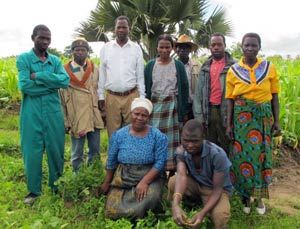
SIMLESA in Mozambique
In Angonia District, of Tete Province, Mozambique,maize is intercropped with sugar beans, known as manteiga in the local language. The people here speak Chichewa, which is also spoken in Malawi. Weed control is a major problem in the region as herbicides are not widely used, and farmers do not always understand that they must weed all year long, not just when the crop begins to emerge. The farmers agree that weeding is easier on flat ground as compared to the ridges used in the farmers’ conventional practice. “Our ancestors used [ridges] to control against soil erosion, and we have continued to do so”, says Ernesto Jose, one of the farmers.
Nevertheless, the farmers appreciate the technology that has been introduced through SIMLESA, and would like to have extension workers closely follow their progress to keep them on the right track. “We would like in the next season to have the extension workers present at seeding to guide us on spacing and proper tillage,” said Lucinda Fernando. The farmers are happy that the project will run for at least four years, as it will give them time to reap benefits from the land, and to see how things improve. They were advised that for good results, the trials must be properly managed; plant spacing and row planting must be according to a protocol.
In Chinhadombue Village of Machipanda District, Patricio Lourenço admits that he planted late due to lack of rainfall. He therefore could not apply Roundup (herbicide) for weed control, but maintained a calendar of his activities, and was able to give a blow-by-blow account of his planting and application of fertilizer. Unlike most of the other farmers, he uses oxen to plough his fields, and finds that the reaper is a good tool to use. In addition, he continues, “…since I was introduced to the practice of leaving residue on the land, I can see that it helps retain moisture on the ground, it reduces the growth of weed, and also provides manure.”
According to the Lourenço, the herbicide Roundup is highly effective in weed control. “If this product were available in the shops, we would buy it and use it elsewhere on the farm”, he said. What is the most difficult component of CA? “It is difficult to apply the residue on the land,” was his answer. SIMLESA scientists explained that residue would be readily available next year as stover and other residue from the harvest would be left on the ground.
At the farm of Alberto Martelo, the planting date was affected by a combination of a heavy downpour and the type of soil on his land, which is a moisture-retaining clay loam. By his own admission, he did not follow the protocol closely, but said, “… in the future, I will follow the recommended instructions because I now know that planting in rows saves seed.”
Elias Reji planted his crop late as well, but anticipates a reasonable crop once the rains come. Apart from the land dedicated to the trials, he has crops on another part of his farm, but these are not doing so well. “Despite the difficult season the trials are still performing better than my conventional practice”, says farmer Reji. “I think that it will be better for me to switch from farmers’ practice to CA, with herbicide to help manage weeds. With the residue left on the ground, the soil will improve and my crops will grow better”, he concluded.